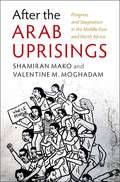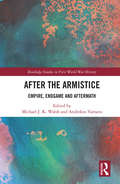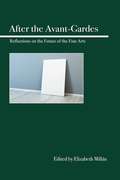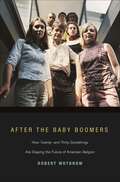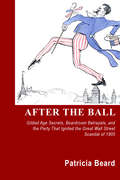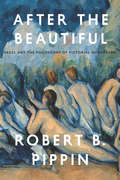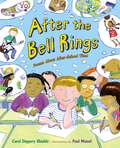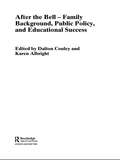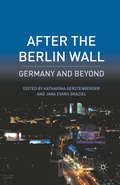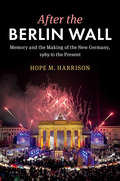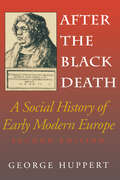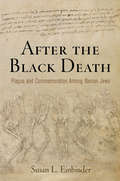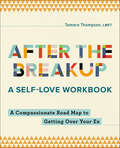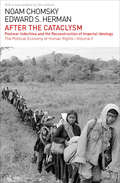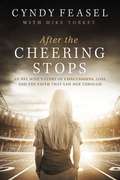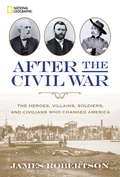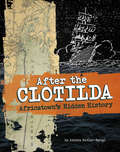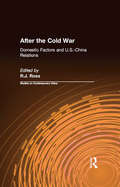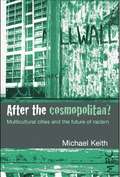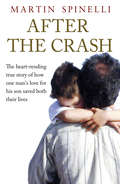- Table View
- List View
After the Arab Uprisings: Progress and Stagnation in the Middle East and North Africa
by Valentine M. Moghadam Shamiran MakoWhy were some, but not all the Arab mass social protests of 2011 accompanied by relatively quick and nonviolent outcomes in the direction of regime change, democracy, and social transformation? Why was a democratic transition limited to Tunisia, and why did region-wide democratization not occur? After the Arab Uprisings offers an explanatory framework to answer these central questions, based on four key themes: state and regime type, civil society, gender relations and women's mobilizations, and external influence. Applying these to seven cases: Tunisia, Egypt, Morocco, Bahrain, Libya, Syria, and Yemen, Valentine M. Moghadam and Shamiran Mako highlight the salience of domestic and external factors and forces, uniquely presenting women's legal status, social positions, and organizational capacity, along with the presence or absence of external intervention, as key elements in explaining the divergent outcomes of the Arab Spring uprisings, and extending the analysis to the present day.
After the Armistice: Empire, Endgame and Aftermath (Routledge Studies in First World War History)
by Michael J. K. Walsh; Andrekos VarnavaA century after the Armistice and the associated peace agreements that formally ended the Great War, many issues pertaining to the UK and its empire are yet to be satisfactorily resolved. Accordingly, this volume presents a multi-disciplinary approach to better understanding the post-Armistice Empire across a broad spectrum of disciplines, geographies and chronologies. Through the lens of diplomatic, social, cultural, historical and economic analysis, the chapters engage with the histories of Lagos and Tonga, Cyprus and China, as well as more obvious geographies of empire such as Ireland, India and Australia. Though globally diverse, and encompassing much of the post-Armistice century, the studies are nevertheless united by three common themes: the interrogation of that transitionary ‘moment’ after the Armistice that lingered well beyond the final Treaty of Lausanne in 1924; the utilisation of new research methods and avenues of enquiry to compliment extant debates concerning the legacies of colonialism and nationalism; and the common leitmotif of the British Empire in all its political and cultural complexity. The centenary of the Armistice offers a timely occasion on which to present these studies.
After the Avant-Gardes
by Elizabeth MillánA rallying call for all those who have been disquieted or disgusted by the excesses of artistic modernism. This is a collection of ten provocative essays on the arts, by writers of varied orientations who share a skepticism about the exaggerated role of modernism and the successive avant-gardes in shaping what is accepted as valid contemporary art. The essays cover painting and other visual arts, literature, music, and general observations about all the arts. It is not an exercise in hand-wringing about the current state of the arts, but looks for different directions in which the arts may now fruitfully evolve. Despite the diverse philosophies of the contributors, these essays together constitute a formidable case against the unhealthy impact of avant-gardism on our lives and aesthetic culture. The essays include the following, among others: a study of anti-modernist painter Odd Nerdrum, who sees modernist art as totalitarian; a critique of the avant-gardist neglect of mimesis as a key to art; an evaluation of "the end of art"; a critique of modern art in light of "the aesthetic harm principle"; an examination of Popper's objections to progressivism in music; the presentation of a new paradigm for literature.
After the Baby Boomers: How Twenty- and Thirty-Somethings Are Shaping the Future of American Religion
by Robert WuthnowMuch has been written about the profound impact the post-World War II baby boomers had on American religion. But the lifestyles and beliefs of the generation that has followed--and the influence these younger Americans in their twenties and thirties are having on the face of religion--are not so well understood. It is this next wave of post-boomers that Robert Wuthnow examines in this illuminating book. What are their churchgoing habits and spiritual interests and needs? How does their faith affect their families, their communities, and their politics? Interpreting new evidence from scores of in-depth interviews and surveys, Wuthnow reveals a generation of younger adults who, unlike the baby boomers that preceded them, are taking their time establishing themselves in careers, getting married, starting families of their own, and settling down--resulting in an estimated six million fewer regular churchgoers. He shows how the recent growth in evangelicalism is tapering off, and traces how biblical literalism, while still popular, is becoming less dogmatic and more preoccupied with practical guidance. At the same time, Wuthnow explains how conflicts between religious liberals and conservatives continue--including among new immigrant groups such as Hispanics and Asians--and how in the absence of institutional support many post-boomers have taken a more individualistic, improvised approach to spirituality. Wuthnow's fascinating analysis also explores the impacts of the Internet and so-called virtual churches, and the appeal of megachurches. After the Baby Boomers offers us a tantalizing look at the future of American religion for decades to come.
After the Ball
by Patricia BeardAfter the Ball is that rare true story that reads like an epic novel, a sweeping chronicle of an era, and an intimate account of the hope and betrayal of a son whose father gave him everything--except the training to find his way in territory ruled by the rapacious.James Hazen Hyde was twenty-three in 1899 when he inherited the majority shares in the billion-dollar Equitable Life Assurance Society. Only five years later, he fell from grace in a Wall Street scandal that obsessed the nation and commanded 115 front-page articles in the New York Times.Hyde was intelligent, cultured, and ambitious, but he was no match for an older generation that had mapped the backstreets of high finance. Vying to control the Equitable's vast investment pool, the most famous financiers and industrialists of the era--among them E.H. Harriman, Henry Clay Frick, and J.P. Morgan--put Hyde on forty-eight boards and included him in deals that shook Wall Street. And then, at the pinnacle of social success, he made a fatal miscalculation.On the last night of January 1905, James Hyde held a fabulously flamboyant, eighteenth-century Versailles-themed costume ball. His enemies used the party as the hook to hang him on, claiming that he was too frivolous to run a company dedicated to protecting widows and orphans; and spread the rumor that he had spent two hundred thousand dollars to Equitable money on a night's entertainment. By the time a government investigation established that Hyde had paid the bills himself, his reputation was ruined.The bitter campaign to wrest control of the Equitable and its vast investment capacity from Hyde followed on the heels of the ball. As the fight escalated, clandestine alliance between insurers and Wall Street burst to the surface, exposing techniques that are the stuff of twenty-first-century scandals: self-dealing, insider trading, accounting malpractice, and corporate funding of private pleasure.After the Ball tells a tale that riveted millions of Americans a century ago. Its themes are as fresh today as they were in 1905: greed and chicanery, the flawed love between fathers and sons, and contradictory American attitudes about wealth--all unfolding against a setting of magnificence, excess, and corrupting glamour.Patricia Beard is the author of nine nonfiction books, one novel and hundreds of nationally published magazine articles. She has been an editor at Elle, Town & Country, and Mirabella magazines.An absorbing book about the financial scandal that consumed New York and the nation a century ago, AFTER THE BALL evokes a time of glamorous carelessness in life, love, and high finance.--Arthur M. Schlesinger, Jr. Pulitzer Prize Winning author and historianPatricia Beard's glittering...social history proves that "Plus ça change, plus c'est la même chose." The hubris, extravagance, greed, and social ambitions of the 1990s are perfectly mirrored in this tale of the early 1900s, which reads like a novel...Great fun, but with a sting in the tail--Michael Korda, author of Ike, An American HeroSuperbly researched and suspenseful...a tale of jealousy, greed, and conflicts of interest...reminds us that America's business scandals of the early twenty-first century are hardly unprecedented.--Richard H. Jenrette,Equitable Lie Assurance Society 1987-1996
After the Beautiful: Hegel and the Philosophy of Pictorial Modernism
by Robert B. PippinIn his Berlin lectures on fine art, Hegel argued that art involves a unique form of aesthetic intelligibility—the expression of a distinct collective self-understanding that develops through historical time. Hegel’s approach to art has been influential in a number of different contexts, but in a twist of historical irony Hegel would die just before the most radical artistic revolution in history: modernism. In After the Beautiful, Robert B. Pippin, looking at modernist paintings by artists such as Édouard Manet and Paul Cézanne through Hegel’s lens, does what Hegel never had the chance to do. While Hegel could never engage modernist painting, he did have an understanding of modernity, and in it, art—he famously asserted—was “a thing of the past,” no longer an important vehicle of self-understanding and no longer an indispensable expression of human meaning. Pippin offers a sophisticated exploration of Hegel’s position and its implications. He also shows that had Hegel known how the social institutions of his day would ultimately fail to achieve his own version of genuine equality, a mutuality of recognition, he would have had to explore a different, new role for art in modernity. After laying this groundwork, Pippin goes on to illuminate the dimensions of Hegel’s aesthetic approach in the path-breaking works of Manet, the “grandfather of modernism,” drawing on art historians T. J. Clark and Michael Fried to do so. He concludes with a look at Cézanne, the “father of modernism,” this time as his works illuminate the relationship between Hegel and the philosopher who would challenge Hegel’s account of both modernity and art—Martin Heidegger. Elegantly inter-weaving philosophy and art history, After the Beautiful is a stunning reassessment of the modernist project. It gets at the core of the significance of modernism itself and what it means in general for art to have a history. Ultimately, it is a testament, via Hegel, to the distinctive philosophical achievements of modernist art in the unsettled, tumultuous era we have inherited.
After the Bell Rings: Poems About After-School Time
by Carol Diggory ShieldsFresh, funny, and full of verve and variety, this clever book of 22 illustrated poems about school captures what kids love to do when class lets out. “Finally…. Finally…. Finally…. BRINNNNNG!That wonderful bell begins to ring. “Everyone knows that the best part of the school day is the moment it ends! After school, kids can hang out with their friends, play video games, attend music lessons, avoid chores, practice sports, do homework...well, maybe that last part isn't so great, but the rest is a blast!
After the Bell: Family Background, Public Policy and Educational Success (Routledge Advances In Sociology Ser. #Vol. 12)
by Dalton Conley Karen AlbrightSince the publication of the Coleman report in the US many decades ago, it has been widely accepted that the evidence that schools are marginal in the grand scheme of academic achievement is conclusive. Despite this, educational policy across the world remains focused almost exclusively on schools.With contributions from such figures as Jeanne Broo
After the Berlin Wall: Germany and Beyond
by Beyond GermanyTwenty years after its fall, the wall that divided Berlin and Germany presents a conceptual paradox: on one hand, Germans have sought to erase it completely; on the other, it haunts the imagination in complex and often surprising ways
After the Berlin Wall: Memory and the Making of the New Germany, 1989 to the Present
by Hope M. HarrisonThe history and meaning of the Berlin Wall remain controversial, even three decades after its fall. Drawing on an extensive range of archival sources and interviews, this book profiles key memory activists who have fought to commemorate the history of the Berlin Wall and examines their role in the creation of a new German national narrative. With victims, perpetrators and heroes, the Berlin Wall has joined the Holocaust as an essential part of German collective memory. Key Wall anniversaries have become signposts marking German views of the past, its relevance to the present, and the complicated project of defining German national identity. Considering multiple German approaches to remembering the Wall via memorials, trials, public ceremonies, films, and music, this revelatory work also traces how global memory of the Wall has impacted German memory policy. It depicts the power and fragility of state-backed memory projects, and the potential of such projects to reconcile or divide.
After the Berlin Wall: Putting Two Germanys Back Together Again
by Christopher HiltonOn 7 May 1945, Grand Admiral Donitz, named in Hitler's will as head of state, authorised the unconditional surrender of all German forces to the Allies on the following day. World War II in Europe was at an end. But many of the German people would continue to endure hardships, as both the country and the capital were to be divided between France, the UK and the USA in the west and the USSR in the east. East and West Germany, and East and West Berlin, would remain divided until 1989. By October 1990, however, the two countries were reunited, and the Berlin Reichstag was once again the seat of government. Here, politicians would put East and West back together again, marrying a totalitarian, atheist, communist system with a democratic, Christian, capitalist one. How did this marriage affect the everyday life of ordinary Germans? How did combining two telephone systems, two postal services, hospitals, farm land, property, industry, railways and roads work? How were women's rights, welfare, pensions, trades unions, arts, rents and housing affected? There had been no warning of this marriage and no preparation for it - and no country had ever tried putting two completely opposite systems together before. This is the story of what happened, in the words of the people it happened to - the people's story of an incredible unification.
After the Black Death, Second Edition: A Social History of Early Modern Europe
by George HuppertPraise for the first edition:"To give a sense of immediacy and vividness to the long period in such a short space is a major achievement." —History"Huppert's book is a little masterpiece every teacher should welcome." —Renaissance QuarterlyA work of genuine social history, After the Black Death leads the reader into the real villages and cities of European society. For this second edition, George Huppert has added a new chapter on the incessant warfare of the age and thoroughly updated the bibliographical essay.
After the Black Death: Plague and Commemoration Among Iberian Jews (The Middle Ages Series)
by Susan L. EinbinderThe Black Death of 1348-50 devastated Europe. With mortality estimates ranging from thirty to sixty percent of the population, it was arguably the most significant event of the fourteenth century. Nonetheless, its force varied across the continent, and so did the ways people responded to it. Surprisingly, there is little Jewish writing extant that directly addresses the impact of the plague, or even of the violence that sometimes accompanied it. This absence is particularly notable for Provence and the Iberian Peninsula, despite rich sources on Jewish life throughout the century.In After the Black Death, Susan L. Einbinder uncovers Jewish responses to plague and violence in fourteenth-century Provence and Iberia. Einbinder's original research reveals a wide, heterogeneous series of Jewish literary responses to the plague, including Sephardic liturgical poetry; a medical tractate written by the Jewish physician Abraham Caslari; epitaphs inscribed on the tombstones of twenty-eight Jewish plague victims once buried in Toledo; and a heretofore unstudied liturgical lament written by Moses Nathan, a survivor of an anti-Jewish massacre that occurred in Tàrrega, Catalonia, in 1348.Through elegant translations and masterful readings, After the Black Death exposes the great diversity in Jewish experiences of the plague, shaped as they were by convention, geography, epidemiology, and politics. Most critically, Einbinder traces the continuity of faith, language, and meaning through the years of the plague and its aftermath. Both before and after the Black Death, Jewish texts that deal with tragedy privilege the communal over the personal and affirm resilience over victimhood. Combined with archival and archaeological testimony, these texts ask us to think deeply about the men and women, sometimes perpetrators as well as victims, who confronted the Black Death. As devastating as the Black Death was, it did not shatter the modes of expression and explanation of those who survived it—a discovery that challenges the applicability of modern trauma theory to the medieval context.
After the Breakup: A Compassionate Road Map to Getting Over Your Ex (After the Breakup)
by Tamara ThompsonFind comfort and hope after a breakup with guided exercises in self-lovePicking up the pieces after a breakup can be difficult—but moving on is possible with a little self-love! This write-in workbook will help you process your feelings, develop healthier habits and patterns, and make yourself a priority as you move forward with confidence.Discover the meaning of self-love—Redefine what it means to feel complete by showing up for yourself with love and compassion.Begin to heal—Explore the root causes of your emotions with insightful prompts, practices, and exercises like role-play and visualization.Relatable stories—Get Inspired by real-life stories of others that have endured breakups and found happiness and healing through self-love.A supportive companion workbook—This book expands on the popular After the Breakup: A Self-Love Journal. Use both books together to get the full self-love experience!Build a better relationship with yourself with this uplifting breakup book.
After the Cataclysm: Postwar Indochina and the Reconstruction of Imperial Ideology (The Political Economy of Human Rights #2)
by Noam Chomsky Edward S. HermanVolume two of the influential study of US foreign policy during the Cold War—and the media&’s manipulative coverage—by the authors of Manufacturing Consent. First published in 1979, Noam Chomsky and Edward Herman&’s two-volume work, The Political Economy of Human Rights, is a devastating analysis of the United States government&’s suppression of human rights and support of authoritarianism in Asia, Africa and Latin America during the 1960s and 70s. Still one of the most comprehensive studies of the subject, it demonstrates how government obscured its role in torture, murder and totalitarianism abroad with the aid of the news media. In the first volume, Chomsky and Herman focus on US terror in Indochina. In volume two, After the Cataclysm, the authors examine the immediate aftermath of those actions, with special focus on the Khmer Rouge takeover of Cambodia. Throughout, the authors track the media response to the US interventions—a mixture of willful silence and Orwellian misrepresentation.
After the Cheering Stops: An NFL Wife’s Story of Concussions, Loss, and the Faith that Saw Her Through
by Mike Yorkey Cyndy FeaselFormer NFL wife Cyndy Feasel tells the tragic story of her family's journey into chaos and darkness resulting from the damage her husband suffered due to football-related concussions and head trauma--and the faith that saved her. "If I'd only known what I loved the most would end up killing me and taking away everything I loved, I would have never done it." - Grant Feasel Grant Feasel spent ten years in the NFL, playing 117 games as a center and a long snapper mostly for the Seattle Seahawks. The skull-battering, jaw-shaking collisions he absorbed during those years ultimately destroyed his marriage and fractured his family. Grant died on July 15, 2012, at the age of 52, the victim of alcohol abuse and a degenerative brain disease known as chronic traumatic encephalopathy, or CTE. Cyndy Feasel watched their life together become a living hell as alcohol became Grant's medication for a disease rooted in the scores of concussions he suffered on the football field. Helmet-to-helmet collisions opened the door to CTE and transformed him from a sunny, strong, and loving man into a dark shadow of his former self. In this raw and emotional memoir that takes a closer look at the destruction wrought by a game millions love, Cyndy describes in painful and excruciating detail what can happen to an NFL player and his family when the stadium empties and the lights go down. A powerful tale of warning for football moms and NFL wives everywhere, After the Cheering Stops is also a story of the hard-won hope found in God's presence when everything else falls apart.
After the Civil War
by James RobertsonReturning to the turbulent days of a nation divided, best-selling author and acclaimed historian James Robertson explores 70 fascinating figures who shaped America during Reconstruction and beyond. Relentless politicians, intrepid fighters, cunning innovators--the times called for bold moves, and this resilient generation would not disappoint. From William Tecumseh Sherman, a fierce leader who would revolutionize modern warfare, to Thomas Nast, whose undefeatable weapon was his stirring cartoons, these are the people who weathered the turmoil to see a nation reborn. Following these extraordinary legends from the battle lines to the White House, from budding metropolises to the wooly west, we re-discover the foundation of this great country.From the Hardcover edition. of post-assassination Washington and avenge the Union with harsh punishments for Confederate president Jefferson Davis. Together their stories tell the complex and fast-paced history of America as the country struggled to reunite and adapt to the inevitable changes wrought by war. The Greatest Generation of their day, the 75 figures in this book would forever change--and be changed by--the Civil War.From the Hardcover edition.
After the Civil War: Making Memory and Re-Making Spain since 1936
by Michael RichardsThe Spanish civil war was fought not only on the streets and battlefields from 1936 to 1939 but also through memory and trauma in the decades that followed. This fascinating book re-assesses the eras of war, dictatorship and transition to democracy in light of the memory boom in Spain since the late 1990s. It explores how the civil war and its repressive aftermath have been remembered and represented from 1939 to the present through the interweaving of war memories, political power, and changing social relations. Acknowledgement and remembrance were circumscribed during the war's immediate aftermath and only the victors were free to remember collectively during the long Franco era. Michael Richards recasts social memory as a profoundly historical product of migration, political events and evolving forms of collective identity through the 1950s, the transition to democracy in the 1970s, and in the bitterly contested politics of memory since the 1990s.
After the Civil War: The Heroes, Villains, Soldiers, and Civilians Who Changed America
by James RobertsonIn the chaotic days following Abraham Lincoln's assassination, Washington and the world struggled to come to terms with the loss of the figure who symbolized America's Union. Best-selling author James Robertson brings readers back to 1865, exploring the critical years following the Civil War, and focusing on 75 key figures who would come to shape America during Reconstruction and beyond. We meet Edwin Stanton, the dour secretary of war who would attempt to seize political power amid the chaos of post-assassination Washington and avenge the Union with harsh punishments for Confederate president Jefferson Davis. We meet the "Old Soldiers" such as Winfield Scott, the general who was older than the city of Washington, D.C. when he took command of the Union Army in 1861, and William Tecumseh Sherman, an enigma of a man who would revolutionize modern warfare. And we meet the people whose lives marked shifts in everyday life in the United States, from Edwin Holmes, who would revolutionize the funeral industry, to Clara Barton, who would found the modern Red Cross. Together their stories tell the complex and fast-paced history of America as the country struggled to reunite and adapt to the inevitable changes wrought by war. The Greatest Generation of their day, the 75 figures in this book would forever change - and be hanged by - the Civil War.
After the Civil Wars: English Politics and Government in the Reign of Charles II
by John MillerThe first study of Restoration England from the point of view of both rulers and ruled, this volume offers a vital reappraisal of seventeenth century England. The civil wars had a traumatic effect on the English people: memories of bloodshed and destruction and the ultimate horror of the execution of Charles I continued to be invoked for decades afterwards. It is often argued that the political and religious fissures created by the wars divided English society irrevocably, as demonstrated by the later bitter conflict between the Whig and Tory parties. After the Civil Wars proposes instead that although there was political conflict, Charles II's reign was not a continuation of the divisions of the civil wars.
After the Clotilda: Africatown's Hidden History
by Anitra Butler-NgugiIn 2019, the remains of the Clotilda were discovered in the Mobile River. The discovery of the last slave ship helped document the history of Africatown—a community built by Africans who had been illegally brought to Mobile, Alabama, on that ship in 1860 and enslaved. But for more than 160 years, the people of Africatown have been preserving their own history and culture—and fighting for a hard-won community that has been encroached upon for decades. In this book, students will learn about the survivors of the Clotilda, the community they built, and the people's resilience in the face of environmental racism.
After the Cold War: Domestic Factors and U.S.-China Relations
by R.J. RossAs relations between the United States and China move into a period of intense activity and sensitivity, this timely book addresses the impact of domestic factors in both countries on their post-Cold War/post-Tiananmen relations. The contributors examine the issue from a number of distinct perspectives: the increased impact of domestic factors in both countries due to changing strategic circumstances; the politics of China policy in the United States, with emphasis on the role of interest groups vis-a-vis Congress, the media, and other domestic institutions; the importance of domestic factors in U.S.-China economic conflicts; the combined impact of domestic factors in both China and the United States on the most important conflict of interest in U.S.-China relations -- the Taiwan issue.
After the Cosmopolitan?: Multicultural Cities and the Future of Racism
by Michael KeithAfter the Cosmopolitan? argues that both racial divisions and intercultural dialogue can only be understood in the context of the urbanism through which they are realized. All the key debates in cultural theory and urban studies are covered in detail: the growth of cultural industries and the marketing of cities social exclusion and violence the nature of the ghetto the cross-disciplinary conceptualization of cultural hybridity the politics of third-way social policy. In considering the ways in which race is played out in the world's most eminent cities, Michael Keith shows that neither the utopian naiveté of some invocations of cosmopolitan democracy, nor the pessimism of multicultural hell can adequately make sense of the changing nature of contemporary metropolitan life. Authoritative and informative, this book will be of interest to advanced undergraduates, postgraduates and researchers of anthropology, cultural studies, geography, politics and sociology.
After the Coup: An Ethnographic Reframing of Guatemala 1954
by Timothy J. Smith Abigail E AdamsThis exceptional collection revisits the aftermath of the 1954 coup that ousted the democratically elected Guatemalan president Jacobo Arbenz. Contributors frame the impact of 1954 not only in terms of the liberal reforms and coffee revolutions of the nineteenth century, but also in terms of post-1954 U.S. foreign policy and the genocide of the 1970s and 1980s. This volume is of particular interest in the current era of the United States' re-emerging foreign policy based on preemptive strikes and a presumed clash of civilizations. Recent research and the release of newly declassified U.S. government documents underscore the importance of reading Guatemala's current history through the lens of 1954. Scholars and researchers who have worked in Guatemala from the 1940s to the present articulate how the coup fits into ethnographic representations of Guatemala. Highlighting the voices of individuals with whom they have lived and worked, the contributors also offer an unmatched understanding of how the events preceding and following the coup played out on the ground. Contributors are Abigail E. Adams, Richard N. Adams, David Carey Jr., Christa Little-Siebold, Judith M. Maxwell, Victor D. Montejo, June C. Nash, and Timothy J. Smith.
After the Crash
by Martin Spinelli'In the pit of my stomach, as I kissed my four-year-old son Lio and my darling wife Sasha goodbye, I knew something was up. By that evening, the police had told me about the crash.'Lio's bright and talented mother was killed that day, and he narrowly escaped the same fate. But instead of it being an ending for us, the crash was a beginning.'Lio's miraculous recovery from severe brain damage and a coma defied medical science. As I witnessed his astonishing journey - from intensive care bed to 10 Downing Street - and fought to pull him through horrific injuries and the loss of his mother, I found real purpose and meaning for the first time in my life.'After the Crash is much more than a moving personal story. It's a handbook for dealing with disaster, not just surviving it but mastering it and using it to transform your life for the better.
